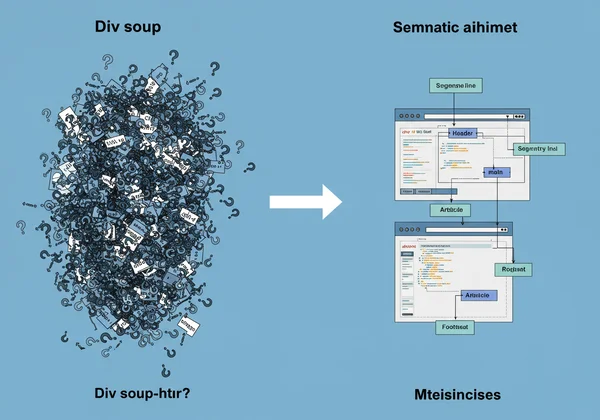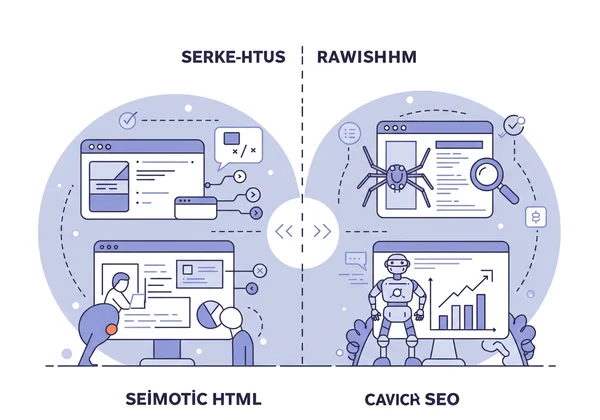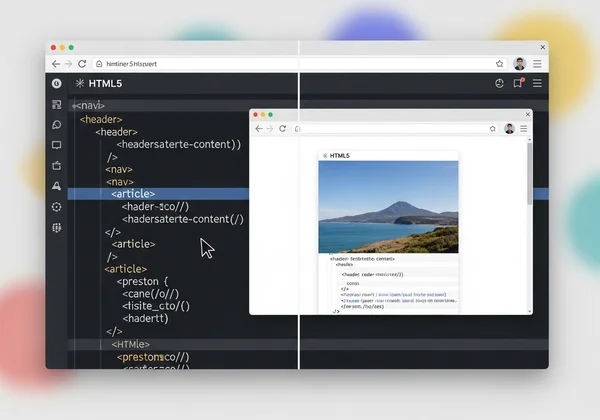Semantic HTML5 Guide: Structure Web with HTML Viewer & Online Editor
Semantic HTML5 isn't just a buzzword; it's the backbone of accessible, SEO-friendly, and maintainable web development. But what is an html viewer and how can it help you master this crucial skill? Discover how Html Viewer can be your go-to partner for crafting meaningful web structures, making your development workflow smoother and more insightful. Get ready to transform your code from a simple layout into an intelligent document with our free html viewer.

Understanding Semantic HTML: Beyond Divs & Spans
For years, developers relied heavily on <div> and <span> tags to build websites. While functional, these non-semantic elements offer no information about the content they hold. This leads to what is often called "div soup"—a confusing and meaningless block of code. Semantic HTML introduces tags that describe their meaning to both the browser and the developer, creating a more logical and descriptive document structure.
What Exactly is Semantic HTML and Why is it Essential?
At its core, semantic HTML is the practice of using HTML markup to reinforce the meaning of the information in web pages rather than just defining its presentation. For example, instead of using <div class="header">, semantic practice dictates using the <header> tag. This immediately tells browsers, search engines, and assistive technologies that this section contains introductory content or navigation links.
This practice is essential for several reasons. It improves code readability, making it easier for other developers (or your future self) to understand and maintain the codebase. It also creates a more resilient foundation for your CSS and JavaScript, as your styles and scripts can target clear, predictable elements. This clear structure is a cornerstone of modern web development best practices.
The Crucial Impact on Web Accessibility & SEO HTML
The two most significant benefits of using semantic HTML are profound improvements in web accessibility and SEO. For accessibility, screen readers and other assistive devices rely on the document's structure to provide context to users with disabilities. A semantic <nav> element allows a user to instantly jump to the navigation, while a non-semantic <div> provides no such shortcut. Using proper tags like <main>, <article>, and <aside> creates a logical map of your page that everyone can follow.

For search engines, a well-structured document is easier to crawl and understand. Search bots use this semantic information to identify key pieces of content, such as page titles, main articles, and contact information. Using SEO HTML correctly—like wrapping your main blog post in an <article> tag and using proper heading levels (H1, H2, H3)—can directly contribute to better search rankings by helping engines accurately index your content's purpose and hierarchy.
Key HTML5 Structure Elements to Know
HTML5 introduced a host of new elements designed to give developers the tools they need to build semantically rich websites. Understanding these tags is the first step toward writing cleaner, more effective code. You can easily experiment with these tags using an online html editor to see how they behave.
Common Structural Tags: Header, Nav, Main, Article, Section, Footer, Aside
These elements form the primary skeleton of most web pages. Think of them as the main building blocks that define the layout and purpose of different areas.
-
<header>: Represents introductory content for its nearest ancestor sectioning content or for the entire page. It often contains a logo, a search form, or the main heading. -
<nav>: Designates a section of the page whose purpose is to provide navigation links, either within the current document or to other documents. -
<main>: Specifies the main, dominant content of the<body>of a document. There should only be one<main>element per page. -
<article>: Represents a self-contained composition in a document that is intended to be independently distributable or reusable, e.g., a forum post, a magazine or newspaper article, or a blog entry. -
<section>: Defines a thematic grouping of content, typically with a heading. It's a way to break up a large article into logical parts. -
<footer>: Represents the footer for its nearest sectioning content or the page itself. It usually contains authorship information, copyright data, or links to related documents. -
<aside>: Represents a portion of a document whose content is only indirectly related to the document's main content, like sidebars or call-out boxes.

Content-Specific Elements: Figure, Figcaption, Time, Mark
Beyond the main structure, other semantic elements help add meaning to specific types of content within your layout.
<figure>: Used to encapsulate media such as an image, illustration, diagram, or code snippet.<figcaption>: Provides a caption or legend for its parent<figure>element, linking the description directly to the media.<time>: Allows you to encode dates and times in a machine-readable format.<mark>: Represents text which is marked or highlighted for reference or notation purposes.
Visualize & Validate Semantic HTML with HTML Viewer Online
Knowing the theory is one thing, but putting it into practice is where true learning happens. This is where an HTML viewer online becomes an invaluable asset. Our tool is designed to be the perfect sandbox for developers, designers, and learners to instantly see the impact of their code, making the abstract concepts of semantics tangible and easy to grasp.
Real-time HTML Preview: See Your Structure Instantly
How do you preview an HTML page without a complex setup? It's simple. You can paste your code directly into our online tool and see it render in real-time. This instant feedback loop is very effective. For a beginner, it creates a direct connection between the <nav> tag they just typed and the navigation bar that appears in the preview pane. For a designer, it allows for rapid tweaks to see how a new <section> affects the overall layout.

Using Html Viewer to Audit & Beautify Semantic Code
One of the best ways to learn is by studying the work of others. With the URL import feature, you can view the HTML source of any website. However, raw source code can be messy and hard to read. That's where the HTML beautifier function comes in. With a single click, our tool formats the code with proper indentation and line breaks, revealing its true semantic structure. This is perfect for SEO experts auditing a competitor's heading structure or for developers looking for inspiration from well-crafted sites.
Rapid Prototyping & Learning HTML Elements Online
For experienced developers, setting up a local server just to test a small code snippet is overkill. An online HTML editor online provides a lightweight, no-fuss environment for rapid prototyping. You can experiment with different HTML5 elements, test CSS compatibility, and refine your structure without any configuration. For learners, this provides a safe space to make mistakes, experiment freely, and build confidence by seeing immediate visual results from their code. It's the ideal way to view html online and learn by doing.
Mastering Semantic HTML with the Right Tools
Mastering semantic HTML is crucial for modern web projects. It's a fundamental practice that not only improves your code but also makes your websites better for everyone. It enhances accessibility, boosts your SEO potential, and makes your code more professional and maintainable.
The right tools can significantly simplify the journey to mastering semantic HTML. An HTML viewer, for instance, offers a perfect platform to visualize, test, and refine your code. Whether you're a seasoned developer, a curious designer, or just starting, our tool is here to help you. Ready to elevate your code? Visit our online HTML editor now and start building better, more meaningful websites today.
Frequently Asked Questions About Semantic HTML & Html Viewer
What is an HTML Viewer and How Does It Help with Semantic HTML?
An HTML Viewer is an online tool that allows you to write or paste HTML code and instantly see the rendered visual output. It helps with semantic HTML by providing a real-time preview, so you can see how tags like <article> or <nav> structure your content. With our tool, you can also use the beautify feature to clean up code, making it easier to analyze its semantic structure.
How Do I Check My HTML for Semantic Correctness?
A great way to check for semantic correctness is to use a tool that lets you inspect the code clearly. You can paste your code or a website's URL into an online html viewer. After using the "Beautify" function to format the code, you can manually review the structure. Ask yourself: Does the header use <header>? Is the main content wrapped in <main>? Are lists used for list items? This visual audit is a powerful first step.
Does Using Semantic HTML Improve My Website's SEO?
Yes, absolutely. While it's not a magic bullet, semantic HTML is a key component of technical SEO. Search engines like Google use the semantic meaning of tags to better understand the hierarchy and context of your content. Using a clear structure with tags like <main>, <article>, and proper headings (H1, H2) helps search bots index your site more effectively, which can lead to improved rankings for relevant queries.
Can I Preview an HTML File with Semantic Elements Online?
Yes, you can easily preview an HTML page or file online. Most online HTML viewers, including ours, allow you to copy the contents of your local HTML file and paste it directly into the editor. The tool will then render a live preview instantly, showing you exactly how your semantic elements are interpreted by a browser.
Is Html Viewer an Effective Tool for Learning HTML Structure?
It is a highly effective learning tool. For beginners, the instant visual feedback loop provided by an HTML view is crucial for understanding how code translates to a webpage. The ability to paste code from other websites and use the html formatter helps deconstruct professional sites, offering invaluable insights into how proper HTML structure is implemented in the real world. You can test your code and experiment without fear of breaking anything.